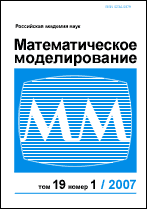|
This article is cited in 1 scientific paper (total in 1 paper)
Eigenvalue problem for the Navier–Stokes operator in cylindrical coordinates
V. G. Priymak
Institute for Mathematical Modeling, Russian Academy of Sciences, Moscow, Russia
Abstract:
The main objective of our work is to develop fast, accurate and robust numerical algorithm suitable for parametric studies of pipe flow stability and related problems. Algorithm constructed covers discretization and efficient solution of the eigenvalue problem for the linearized Navier–Stokes operator in cylindrical coordinates. Moreover, new algorithm (or its fragments) may have wider applicability including the situations when computational domain contains coordinate singularity along the polar axis $r=0$ and when the dependence on azimuth angle can be represented as a Fourier series due to physical symmetry of the problem. Such important flow configurations as incompressible and compressible flows in circular pipes and round jets satisfy these conditions. Algorithm is based on a new change of dependent variables that avoids singularity problems taking into account special behaviour of analytic functions in the vicinity of singularity point. Being written in new variables Navier–Stokes equations can be discretized then without loss of accuracy by using Galerkin trigonometric approximation in azimuthal and streamwise directions and Chebyshev collocation technique in radial direction. In spite of the presence of coordinate singularities algorithm provides spectral accuracy and is weakly sensitive to the roundoff errors. Numerical solution of the linear stability problem implies the Navier–Stokes spatial discretization followed by their linearization about stationary solution and reducing to a standard eigenvalue problem $\lambda x=Tx$. Eigenvalues $\lambda$ may then be calculated by means of the QR-algorithm. Reduction of the discrete equations to the canonical form $\lambda x=Tx$ is an important stage of the solution procedure. We suggest an original reduction algorithm that makes use of influence matrices technique, is economical and to some extent insensitive to the roundoff errors. As far as we know, similar algorithms were not used before. Even in Cartesian coordinates where the implementation of influence matrices is straightforward.
Received: 08.04.2008
Citation:
V. G. Priymak, “Eigenvalue problem for the Navier–Stokes operator in cylindrical coordinates”, Matem. Mod., 21:10 (2009), 29–46; Math. Models Comput. Simul., 2:3 (2010), 317–333
Linking options:
https://www.mathnet.ru/eng/mm2888 https://www.mathnet.ru/eng/mm/v21/i10/p29
|

|




 Contact us:
Contact us: Terms of Use
Terms of Use
 Registration to the website
Registration to the website Logotypes
Logotypes








 Citation in format
Citation in format 
